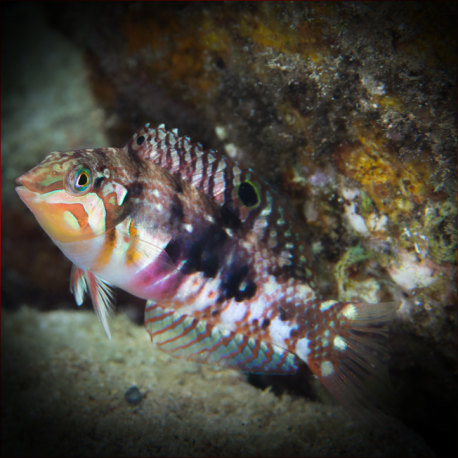More info
Datasheet
| Minimum Tank Size | 300 litres / 79.25 US gallons |
| Maximum Size | 12.0cm / 4.72inches |
| Reef Compatible | Reef safe with caution |
| Temperament | Mostly peaceful but might be aggressive towards similar species |
| Temperature | 22.2°C / 71.96°F - 25.6°C / 78.08°F |
| Specific Gravity | 1.020-1.025 |
| Carbonate Hardness | 8-12 |
| pH | 8.1-8.4 |
General Description
The Nebulous wrasse, scientifically known as Halichoeres nebulosus, belongs to the family Labridae. These fish are highly favored in aquariums for their beauty and effectiveness in controlling flatworms and pyramid snails. They are generally more peaceful compared to other wrasse species but can outgrow smaller aquariums as they reach a maximum size of 12.0cm. Nebulous wrasse are known to dig into the sand for protection or sleep and must be monitored for any injuries, especially around the mouth, during transportation.
Aquarium Suitability
The Nebulous wrasse is suitable for aquariums with proper care and attention. They function best as a pair (one male and one female) or with one male and several females. These fish have an average hardiness level and require a minimum tank size of 300 liters. It is crucial to provide a deep sandy substrate of at least 5 cm to allow them to burrow when threatened or resting.
Demands and Care
Nebulous wrasse are known to be sensitive during transportation and acclimatization into the aquarium. Their varied diet includes larger crustaceans, other invertebrates, small crustaceans, and zooplankton. They are reef-safe with caution and exhibit mostly peaceful behavior, though they can be aggressive towards similar species.
Reef Suitability
Categorized as reef safe with caution, Nebulous wrasse can be a threat to small crustaceans like shrimp and are known to consume tubeworms. They have specific water condition requirements including a KH of 8-12, pH of 8.1-8.4, salinity of 1.020-1.025, and a temperature range of 22.2-25.6 degrees Celsius.
Aquarium Setup
To set up an aquarium for Nebulous wrasse, ensure a minimum tank size of 300 liters with a deep sandy substrate for burrowing. Maintain water conditions with suitable parameters and provide hiding spots and spaces for them to move freely. Avoid open aquariums as these fish have been known to jump out when given the opportunity.
Behaviour
Nebulous wrasse have an intricate biological clock that may require time to adjust after transportation. They can change gender from female to male and are known to smash larger prey against rocks. Observing their behavior and ensuring a peaceful tank environment is essential for their well-being.
Feeding and Diet
These wrasse feed on a variety of foods, including larger crustaceans, small crustaceans, zooplankton, and other invertebrates. They are effective in combating flatworms and pyramid snails but may exhibit individual preferences in their diet.
Dimorphism
Nebulous wrasse are hermaphroditic, capable of changing gender from female to male when needed. When introducing multiple wrasse, monitor their interactions to prevent aggression or territorial disputes.
Habitat and Distribution
These wrasse species are found in various locations, including the East Indian Ocean, West Indian Ocean, Australia, Japan, the Red Sea, Indonesia, and the Central/West Pacific. Their natural habitat includes reef environments where they play a vital role in controlling unwanted invertebrate populations.

